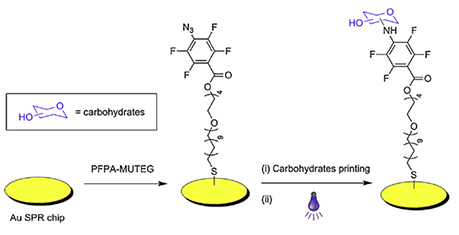Surface Plasmon Resonance imaging (SPRi), namely surface plasmon resonance microscopy (SPRM) is an optical technique that is used to spatially monitor localized differences in the reflectivity of incident light from a prism-gold film interface that result from molecules adsorbing to or desorbing from the gold film. It can realize label-free, real-time, highly sensitive, quantitative, high-throughput biological interaction monitoring and the binding profiles from multi-analytes further provide the binding kinetic parameters between different biomolecules. What's more, SPR imaging can be used to directly study the interactions of the carbohydrate arrays with proteins adsorbing from solution without the use of a reporter group.
In addition to the benefits afforded from the increased functional affinity and specificity of a surface-based assay format, the use of SPR to monitor protein-carbohydrate interactions with carbohydrate arrays has distinct advantages over fluorescence methods. Specifically, lower affinity interactions can be detected because SPR measurements can be made in the presence of a large excess of unbound protein, without the background problems that would complicate a similar measurement using fluorescence based techniques.
 Fig1. Fabrication of carbohydrate-conjugated SPRi sensors (A. Tyagi et al. 2010)
Fig1. Fabrication of carbohydrate-conjugated SPRi sensors (A. Tyagi et al. 2010)
Cell recognition is based on protein-carbohydrate interactions such as cell adhesion, transport, apoptosis, and immune responses. Since lectins have a carbohydrate-binding domain, these interactions can be shown on cell surfaces and lectins by glycoproteins, glycolipids and polysaccharides, but these interactions are usually weak. So SPRi technology provides a good tool for protein-carbohydrate interactions research, and it is essential for understanding biological functions and the role these interactions play in disease states.
Creative Peptides provides professional SPR analysis services, we can follow the customer's request for high-precision analysis of protein/peptide-carbohydrate interactions while ensuring reasonable price and accurate analytical data.
Our strengths:
References